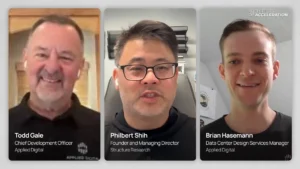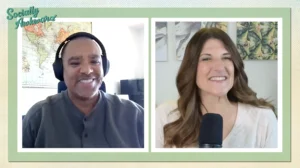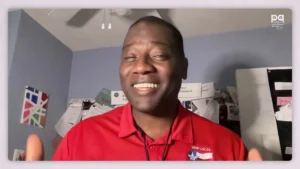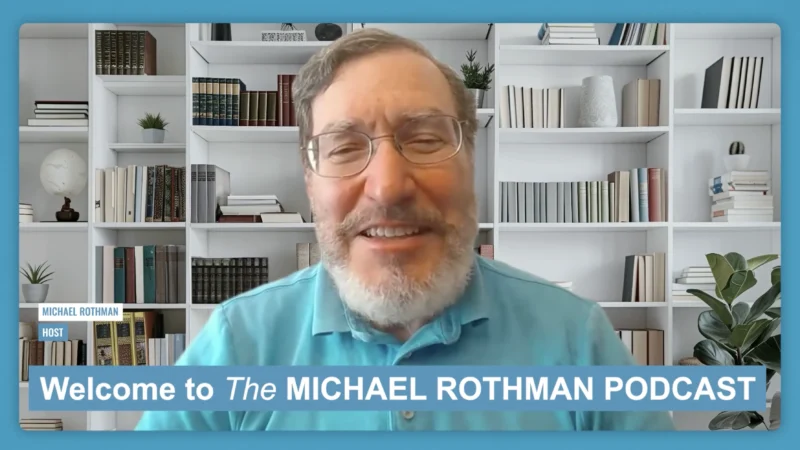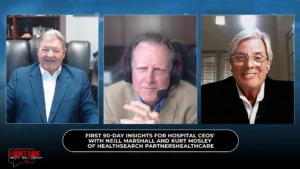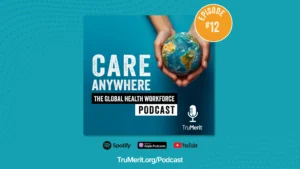Preparing Medical Professionals for Revolutionized Senior Care with Heather Kelley of WRAAA
Nothing changes faster than training in any industry, said our guest Heather Kelley today, Chief Information Officer for the Western Reserve Area Agency on Aging. In senior care, training medical professionals for a new wave of connectivity is a labor-intensive task; not only does increased connectivity with patients bring compliance and information safety issues, but the entire role of a care manager evolves from just providing care to more extensive emotional support as well. Where will this evolution of MedTech leave professionals today, or 10 years down the line?
Kelley joined on the Healthcare podcast to dig in to this changing landscape of senior care, especially on the professionals who run it every day. “You have to make sure that follow those rules and the compliance rules and the safety behind it. You want to make sure that you’re keeping yourself safe in an environment as well,” Kelley said. “You may feel like walking into a consumer’s home is safe and you feel safe there, but the environment outside of that is not safe.” She explores the effects of MedTech on aging patients, providers and care managers, and why this is only the tip of the iceberg.
For more information on WRAAA and their support for the aging community, you can visit their website here.
HIGHLIGHTS FROM THE EPISODE
Daniel Litwin: So I mean it sounds like just on the interpersonal end between a child and their aging parents, the technology is obviously leaps and bounds where it was 10 years ago and you have way better access to communicate, to have more authentic conversations, and sort of just to keep that relationship alive way more easily. And I guess now we’re seeing this extend into healthcare even and that same technology is now making it easier to connect and to take care of your patients.
So I guess what you’re saying here is that you’re seeing a shift to where this technology is allowing medical professionals to better take care of their patients while allowing them to stay more independent and remain at their home and not necessarily always have to, “Okay, you know, my parent is aging. It’s time to take them to a facility.” Now it is like, “Okay, this technology is improving to make their home the facility almost and to make it so that they don’t feel the need that they have to leave the comfort of their own home.”
Heather Kelley: Yeah, absolutely. With things even like doctors on call and those kinds of things that you see out in the community now where you can FaceTime with your doctor and say, “I have a really bad cold,” or, “I have a strep throat or something. Can you call in a prescription for me?” You don’t have to physically go see your doctor anymore. Does that provide better care? In one aspect I believe it does because it’s a more rapid type of care.
So for us being able to do things like that for our consumers and provide them a more rapid type of response, I think it does completely change the bend on healthcare. Will it in the future be what healthcare is? I believe it will be. We used to have our visiting doctors years ago who would come to your house and take care if you are sick and those types of things. I don’t think we’ll get back to that, but we’ll get back to the point where they will be so much more accessible that calling your doctor and making an appointment will become old school.
You won’t need to do that anymore. You’ll be able to blog with your doctor. You’ll be able to keep up and answer questions with your doctor online. Whereas instead of having a face-to-face conversation, which I’m not saying that’s not important because it is, it’s good to have that relationship with your care providers and with your medical staff, but I believe that technology will just keep pushing us that direction. I don’t know if we can avoid that and it’s not necessarily a bad thing.
More people will get the type of urgent care that they need instead of being waited on a list somewhere. You can be more productive in less amount of time.
DL: Right. And yeah, I feel like it’s a representative shift, representative of a greater shift in just med tech in general that everything’s teleblank, telemedicine, teletherapy.
HK: That’s right.
DL: It’s the way of the future and it’s starting to become less of a niche innovation push within the industry, but it’s starting to become more ubiquitous. But I think with senior care, there is a bit of a difference. There are specifics that go into taking care of the aging versus just a classic checkup. So what about providing remote services for senior care is different than other types of care? How do you have to adapt that technology to fit that kind of patient?
HK: Well, you’re not going to be able to walk into an aging consumer’s home and say, “Okay, here’s your iPhone and you will be able to FaceTime with me any time you want.” They’re going to look at you like you’re crazy because it’s like, “You can tell me once, but I’m really afraid to use that technology.” There are some that embrace it and love it because their grandchildren and things like that. But when they’re already not well or needing care, adding complication to an already complicated day is not the way to solve the problem. But could we put iPads in their homes where they press one button and they’re connected to an urgent care provider or they’re connected to their care manager or the person who they trust? Because that’d be a family member, sure, but when it comes to medical, they tend to want the medical advice side of things, whereas a care manager can say, “Yes, I am confirming your appointment. I will see you tomorrow. It’s nice to see you. Have a good evening.”
It’s those types of interactions where they don’t have to do a lot. They’re one button press away from just easing the anxiety. That alone causes everything else to just go smoother. A lot of their concerns are just anxiety related. They really want to just talk to somebody and make sure that I’m supposed to see somebody tomorrow, I really just want to make sure I’m going to see somebody tomorrow. And is it 7 o’clock at night? Yes. But it’s that interaction with the person that they know cares for them and they have that little bit deeper relationship with even sometimes more so than their family because that care manager, not in the intimate relationship, but it is that level where they have conversations and they trust them and the trust is the biggest piece of it.
So I believe they will be. I mean refrigerators have it now where you can look inside your refrigerator when you’re at the grocery store and know if you need milk or not. It’s going to be that type of thing. Can you look in on your family and make sure that they’re okay? Sure. Videos all over the place now. Everybody has video in their house making sure they’re not being broken into, those types of things, but we can layer the security on top of that and layer the technology on top of that that makes them still feel secure in their home and they remain in the place where they can be independent yet feel safe and secure and that they’re going to be well taken care of.
DL: Right. Well, you know, what’s interesting about the way technology is affecting the professionals within senior care is that, to a degree, this heightened level of connectivity now where you can have a patient dial up, your care manager, and ask just the simple questions and really develop that personal relationship. You know, being a healthcare provider now, whoever fills that role isn’t just about providing care. It’s almost becoming kind of a consulate role, like you are a counselor. You are there for guidance, you’re there for emotional support. So I feel like the training now that has to go into preparing these professionals for providing aging care changes as the technology changes because you’re just that much more connected with your patient so your care has to evolve to be on par with that connectivity.
HK: That’s exactly right. Nothing changes faster than training in any industry. There’s always a new way. There’s always a new format. There’s always a new outreach. There’s always something new. And we have to make sure that, first of all, that people have the passion to learn it, that you have to want to know what’s coming and know what’s over the horizon and be hungry for that type of information. We here at our agency, we push training, we love to train our people, lunch and learns. We have an amazing facility here now that is a training room where we can sit down with 80 of our care managers at a time, get the interaction between them, we get the one-on-one FaceTime with them. We’re able to loop in video conferencing with that. So those that can’t physically be here, they’re still part of that. So they feel more like a team. They feel more integrated and they share better stories and they share better ideas and ways to keep what we’re doing relevant and to make sure that we know. It may not be something that’s so much of a concern now, but it’s on the horizon. So we have to be prepared for that and you can’t ever avoid that piece of it, that knowing piece of it, the knowledge piece of it is critical. It’s absolutely critical.
DL: Right. Knowledge of how you’ve done it but also adapting to that knowledge of the new way. Have you noticed any issues in changing that training for sort of this next evolution of aging care as you have professionals going through their training and learning how to best care for their patients now that there is that extra added level of connectivity? Do you see any new challenges and things to teach these professionals?
HK: Well, sure. On the compliance side of things even, you have to be very cautious now with mobile devices and things with recording devices. Things can be recorded. Pictures can be taken. And iPhones can be dangerous in certain environments if we’re not careful. So our care managers and our field staff have to know these are the regulations. These HIPAA regulations are so critical. You have to make sure that follow those rules and the compliance rules and the safety behind it. You want to make sure that you’re keeping yourself safe in an environment as well. You may feel like walking into a consumer’s home is safe and you feel safe there, but the environment outside of that is not safe.
So it’s teaching them how to watch out for themselves, how to watch out for their environment and how important what they’re exposed to is and how to handle that information. So internally and training now has changed so much. There’s so much of it that is online. We do a lot here in the agency that way. We can reach a lot more of our people at one time it all being cloud-based and web-based so that they can not necessarily have to be in the office to do it, but it keeps them up to par because they are able to access that training from wherever they are. And that changes all the time.
Every new person that comes into the agency it seems like there’s always a new layer and level of training to prepare them to do that social work type of job that they’re going to be doing and those care manager type of roles that they’re going to be involved in.
For the latest news, videos, and podcasts in the Healthcare Industry, be sure to subscribe to our industry publication.
Follow us on social media for the latest updates in B2B!
Twitter – @HealthMKSL
Facebook – facebook.com/marketscale
LinkedIn – linkedin.com/company/marketscale



